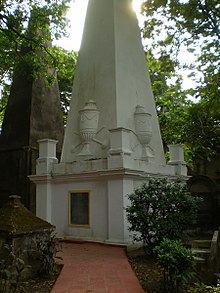South Park Street Cemetery
| South Park Street Cemetery | |
|---|---|
 South Park Street Cemetery main entrance | |
 | |
| Details | |
| Established | 1767 |
| Location | |
| Country | India |
| Coordinates | 22°32′47″N 88°21′37″E / 22.54639°N 88.36028°E |
| Type | Historic |
| Owned by | Christian Burial Board, Kolkata |
South Park Street Cemetery, formerly known as the 'Great Christian Burial Ground', was one of the earliest non-church cemeteries in the world.
History

The burial ground, along with a new road leading to it, known as the Burial Ground Road, was built in 1767. The cemetery and the road were later renamed Park Street after a private deer park established by Sir
After the independence of India, the Park Street cemeteries were decided to be leveled off, as funding for the colonial civil cemeteries were withdrawn. This decision met with resistance from Anglo-Indian citizens of Calcutta.[1] In 1953, the North Park Street Cemetery was decided to be demolished, and the income obtained by leasing the land was used to upkeep the South Park Street Cemetery.[1] In the late 1970s, the cemetery came under the purview of the Association for the Preservation of Historical Cemeteries in India (APHCI) and the Christian Burial Board.
In 1984, Apeejay Trust attempted to demolish the cemetery in order to build an arts center, which was later stopped by an intervention from the Calcutta High Court.[4][5] Nevertheless, substantial damage had already been done by then, and many graves were lost. The grave of Charles Stuart was destroyed (and was later restored) and the demolition of Derozio's grave had been initiated. In the early 2000s, a restoration project was launched to conserve the cemetery's heritage and prevent its further deterioration.
Notable tombs


- Henry Louis Vivian Derozio (1809–1831), teacher and poet, pioneer of the Young Bengal movement
- Sir Asiatic Society
- Lieutenant-General Sir John Clavering (c.1722–1777), army officer and diplomat
- Augustus Cleveland(1754-1784), colonial administrator
- Captain Edward Cooke (1772–1799), Royal Navy officer
- George Bogle (1746–1781), diplomat
- Colonel Indian Botanic Garden
- Lieutenant-Colonel Colin Mackenzie (1754–1821), Surveyor General of India
- Lieutenant-Colonel Valentine Blacker (1778-1826), Surveyor General of India
- Sir John Hadley D'Oyly, 6th Baronet (1754–1818), politician
- Major-General Charles Stuart (1758–1828), army officer and Indophile, popularly known as “Hindoo Stuart”
- Walter Landor Dickens, son of English novelist Charles Dickens. He was buried initially in Bhowanipore war cemetery, and the tombstone was later moved here in 1987.
- Grave no. 363 of an unknown woman (d. 1825) whose epitaph reads “A virtuous mother”.
Architecture
The cemetery is considered to be an important example of colonial-era architecture, with its Gothic-style tombs and monuments, mixed with the rich flavor of the Greek, Egyptian, and Indo-Saracenic styles. In certain instances, elements from Hindu architecture and Islamic tombs have also been adopted.[6] Many of the monuments in the cemetery are adorned with intricate carvings, sculptures, and epitaphs. The structures are primarily constructed of sandstone, marble, and bricks, and feature a variety of shapes and sizes, ranging from simple headstones to grand mausoleums.
Gallery
- South Park Street Cemetery
-
Main gate
-
The marble plaque which reads: "South Park Street Cemetery, opened 1767, closed 1790"
-
The pavilions inside the cemetery
-
A tomb inside the cemetery
-
The tomb of Charles Stuart, known as "Hindoo Stuart"
-
The tombs inside the cemetery
-
Tomb of Sir Henry Vivian Derozio
References
- ^ S2CID 145361099.
- ^ a b Hosking, Sue. "The Great Burial Ground at Chowringhee: Reflections on the South Park Street Cemetary [sic] in Kolkota".
{{cite journal}}: Cite journal requires|journal=(help) - ^ "City of the Dead: South Park Street Cemetery". Sahapedia. Retrieved 5 February 2023.
- ^ "History at stake as buyers bid for South Park Street burial ground in Calcutta". India Today. Retrieved 5 February 2023.
- ^ "Here lies Hindoo Stuart: Inside the 250-year-old Park Street cemetery". The Indian Express. 28 January 2018. Archived from the original on 9 May 2021. Retrieved 23 May 2020.
- ^ "South Park Street Cemetery, Kolkata, India (1767-1790) – An Encyclopedia of Architecture and Colonialism". Retrieved 6 February 2023.
Further reading
- The South Park Street Cemetery, Calcutta, published by the Association for the Preservation of Historical Cemeteries in India, 5th ed. (2009)
- BACSA. South Park Street Cemetery, Calcutta: Register of graves and standing tombs from 1767. London: British Association for Cemeteries in South Asia, 1992.
- Drost, Alexander, Tod und Erinnerung in der kolonialen Gesellschaft. Koloniale Sepulkralkultur in Bengalen (17.-19. Jahrhundert), Jena: Leander Wissenschaft, 2011. https://www.academia.edu/5444685






